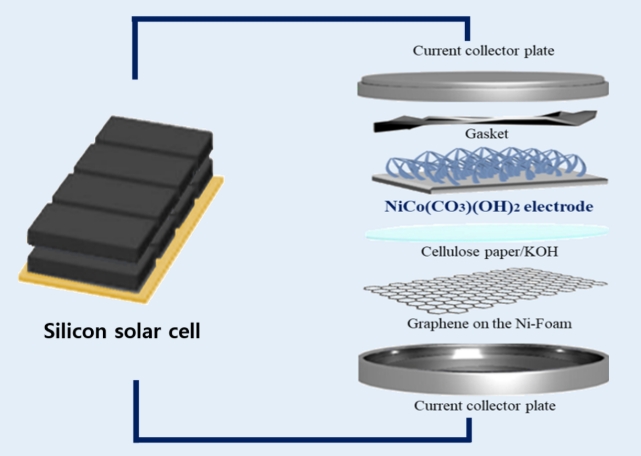
To build these electrodes, the scientists used a nickel-based carbonate and hydroxide composite material, which are said to optimize their conductivity and stability. They initially tested transition metal ions such as manganese (Mn), carbon monoxide (Co), copper (Cu), iron (Fe), and zinc (Zn) and found that the optimal nanostructure of the electrodes depended on the transition metals used.
“Electrodes with optimal electrochemical properties were obtained depending on the choice of transition metals,” they explained noting that, among the synthesized binary metal compounds, a compound made of Ni, Co, hydroxide (OH) offered the best performance, with a capacity retention rate of 87.1 % after 5,000 cycles.
The proposed system consists of a solar cell, a current collector plate, a gasket, the proposed electrode, a cellulose paper layer, and a second current collector plate. It also includes a graphene layer as the anode.
The system achieved energy densities of 35.5 Wh/kg and 13.6 Wh/kg and power densities of 2,555.6 W/kg and 1,2262.5 W/kg at current densities of 2 A/g and 15 A/g, respectively. It also achieved an energy efficiency of 63% and an overall efficiency of 5.17 % under an illumination intensity of 10 mW cm2.
According to the researchers, the device's power density is significantly higher than that of similar devices, which usually do not exceed 1,000 W/kg. “The system demonstrates the ability to release higher power rapidly, enabling immediate energy supply even for high-power devices,” they explained. “Additionally, the performance showed minimal degradation during repeated charge and discharge cycles, confirming the long-term usability of the device.”
Looking forward, they are aiming for the implementation of high-performance supercapacitors and drive future-oriented research efforts. “We will continue to conduct follow-up research to further improve the efficiency of the self-charging device and enhance its potential for commercialization,” they stated.